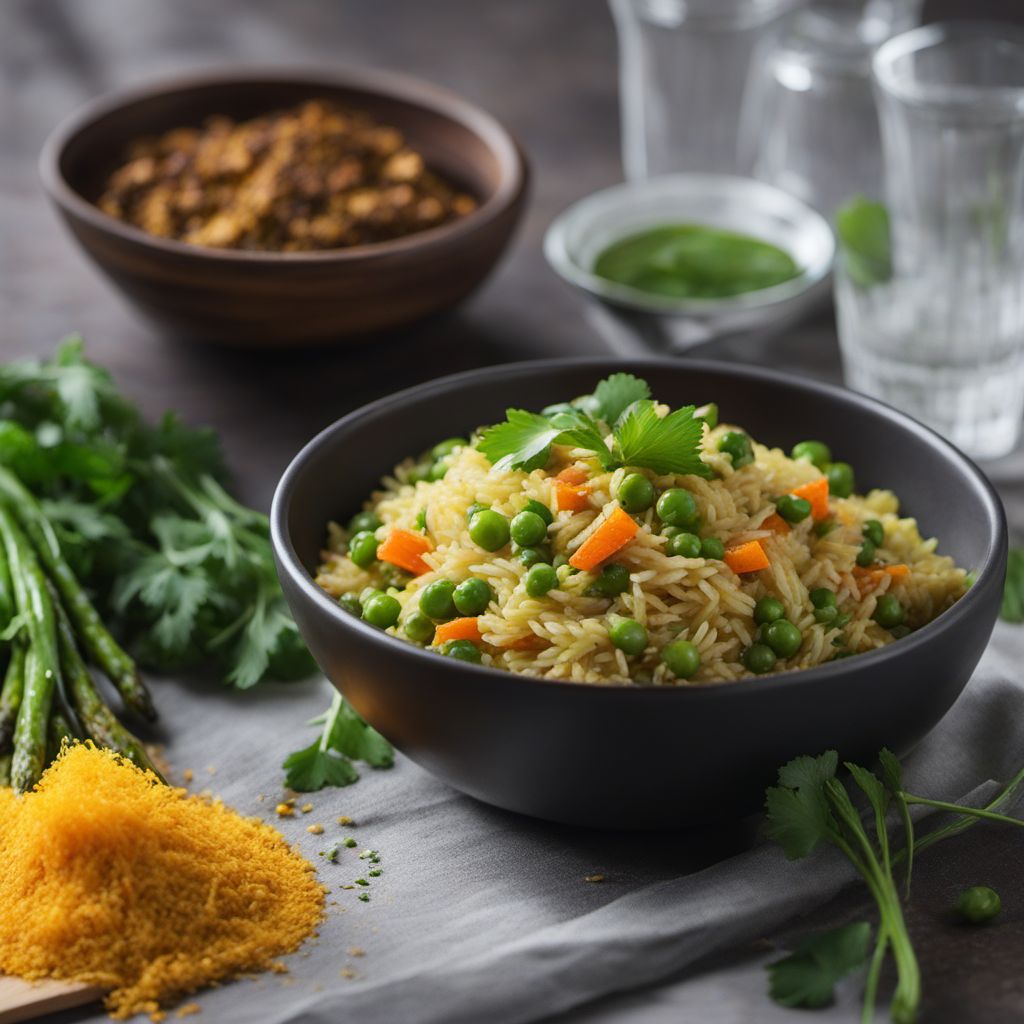
Recipe
Anglo-Indian Spring Vegetable Pilaf
Spiced Pilaf with Fresh Spring Vegetables: A Fusion of Anglo-Indian Flavors
4.6 out of 5
Indulge in the delightful fusion of Anglo-Indian cuisine with this vibrant Spring Vegetable Pilaf. Bursting with the flavors of aromatic spices and seasonal vegetables, this dish is a perfect blend of Italian risotto and Anglo-Indian spices.
Metadata
Preparation time
20 minutes
Cooking time
30 minutes
Total time
50 minutes
Yields
4 servings
Preparation difficulty
Easy
Suitable for
Vegetarian, Vegan (if using vegetable oil instead of ghee), Gluten-free, Dairy-free, Nut-free
Allergens
N/A
Not suitable for
Paleo, Keto, Low-carb, High-protein, Whole30
Ingredients
In this Anglo-Indian adaptation of the Italian risotto primavera, we incorporate the bold and aromatic spices of Anglo-Indian cuisine, such as cumin, turmeric, and garam masala, to infuse the dish with a unique flavor profile. Additionally, we use fragrant basmati rice instead of Arborio rice to enhance the Indian influence. The dish is garnished with fresh cilantro and a squeeze of lemon juice, adding a refreshing element to the traditional risotto. We alse have the original recipe for Risotto primavera, so you can check it out.
-
2 cups (400g) basmati rice 2 cups (400g) basmati rice
-
4 cups (950ml) vegetable broth 4 cups (950ml) vegetable broth
-
1 tablespoon ghee or vegetable oil 1 tablespoon ghee or vegetable oil
-
1 onion, finely chopped 1 onion, finely chopped
-
2 cloves of garlic, minced 2 cloves of garlic, minced
-
1 teaspoon cumin seeds 1 teaspoon cumin seeds
-
1 teaspoon turmeric powder 1 teaspoon turmeric powder
-
1 teaspoon garam masala 1 teaspoon garam masala
-
1 cup (150g) peas 1 cup (150g) peas
-
1 cup (150g) diced carrots 1 cup (150g) diced carrots
-
1 cup (150g) chopped asparagus 1 cup (150g) chopped asparagus
-
Salt, to taste Salt, to taste
-
Freshly ground black pepper, to taste Freshly ground black pepper, to taste
-
Fresh cilantro, for garnish Fresh cilantro, for garnish
-
Lemon wedges, for serving Lemon wedges, for serving
Nutrition
- Calories (kcal / KJ): 320 kcal / 1340 KJ
- Fat (total, saturated): 4g, 1g
- Carbohydrates (total, sugars): 64g, 5g
- Protein: 7g
- Fiber: 5g
- Salt: 1g
Preparation
-
1.Rinse the basmati rice under cold water until the water runs clear. Drain and set aside.
-
2.In a large pot, heat the ghee or vegetable oil over medium heat. Add the chopped onion and minced garlic, and sauté until the onion becomes translucent.
-
3.Add the cumin seeds, turmeric powder, and garam masala to the pot. Stir well to coat the onions and garlic with the spices.
-
4.Add the basmati rice to the pot and stir to combine with the spices and onions. Cook for 2-3 minutes, stirring occasionally.
-
5.Pour in the vegetable broth and bring to a boil. Reduce the heat to low, cover the pot, and simmer for 15 minutes.
-
6.After 15 minutes, add the peas, diced carrots, and chopped asparagus to the pot. Stir gently to incorporate the vegetables into the rice.
-
7.Cover the pot again and continue to simmer for an additional 10-15 minutes, or until the rice is cooked and the vegetables are tender.
-
8.Season the pilaf with salt and freshly ground black pepper to taste.
-
9.Remove the pot from heat and let it sit, covered, for 5 minutes to allow the flavors to meld.
-
10.Fluff the pilaf with a fork before serving. Garnish with fresh cilantro and serve with lemon wedges on the side.
Treat your ingredients with care...
- Basmati rice — Rinse the rice thoroughly to remove excess starch and achieve fluffy grains.
- Cumin seeds — Toast the cumin seeds in a dry pan for a few seconds to enhance their aroma before adding them to the dish.
- Garam masala — Use freshly ground garam masala for the best flavor. If unavailable, store-bought garam masala can be used as a substitute.
Tips & Tricks
- For a richer flavor, you can substitute vegetable broth with homemade vegetable stock.
- Customize the dish by adding other seasonal vegetables like bell peppers or zucchini.
- To make the pilaf more indulgent, top it with toasted slivered almonds or cashews before serving.
- If you prefer a spicier pilaf, add a pinch of red chili flakes or finely chopped green chilies.
- Leftover pilaf can be transformed into delicious stuffed bell peppers by filling the mixture into hollowed-out peppers, topping with cheese, and baking until tender.
Serving advice
Serve the Anglo-Indian Spring Vegetable Pilaf as a main course accompanied by a cooling cucumber raita or a tangy tomato chutney. It can also be served as a side dish alongside grilled chicken or roasted lamb for a complete meal.
Presentation advice
To enhance the presentation, garnish the pilaf with a sprinkle of paprika or a drizzle of coconut milk. Serve it in a colorful serving dish to showcase the vibrant colors of the spring vegetables.
More recipes...
For Risotto primavera
For Italian cuisine » Browse all

Italian Herb-Marinated Beef
Tender Herb-Infused Italian Beef Delight

Necci with Chestnut Flour and Ricotta Filling
Autumn Delight: Necci - Traditional Italian Chestnut Pancakes with Creamy Ricotta Filling

Zuppa Gallurese - Sardinian Cheese and Bread Soup
Sardinian Delight: A Cheesy Bread Soup to Warm Your Soul
For Anglo-Indian cuisine » Browse all
More Italian cuisine dishes » Browse all

Amaretti di Carmignano
Amaretti di Carmignano are a variation of the traditional Italian almond cookie that originated in the town of Carmignano, located in the Tuscany...

Pasta alla pecorara
Pasta alla pecorara is a classic Italian pasta dish that is perfect for a cozy night in. The dish is made with pecorino cheese, which gives it a...

Carne al piatto
Grilled meat
Carne al piatto is a traditional dish from the Tuscany region of Italy.





